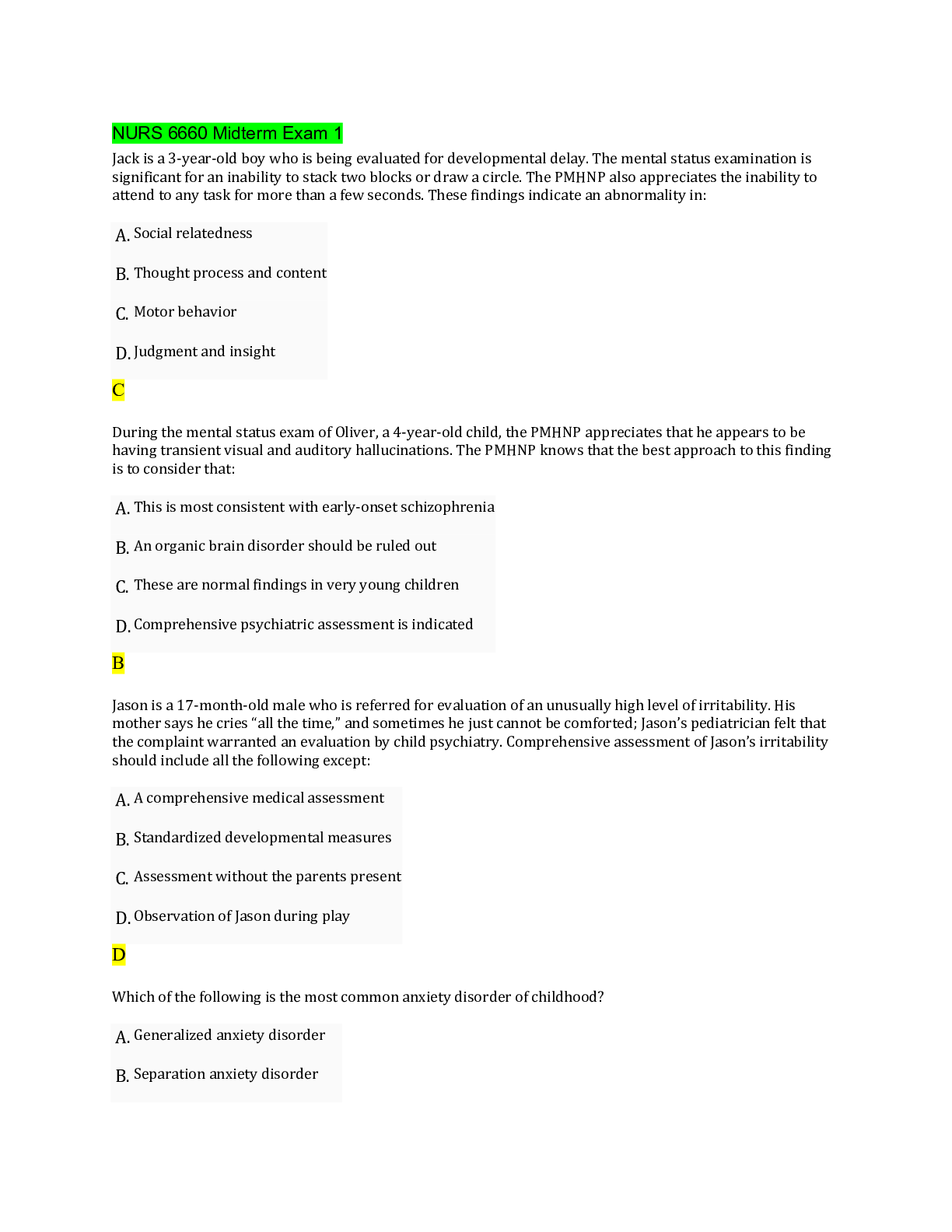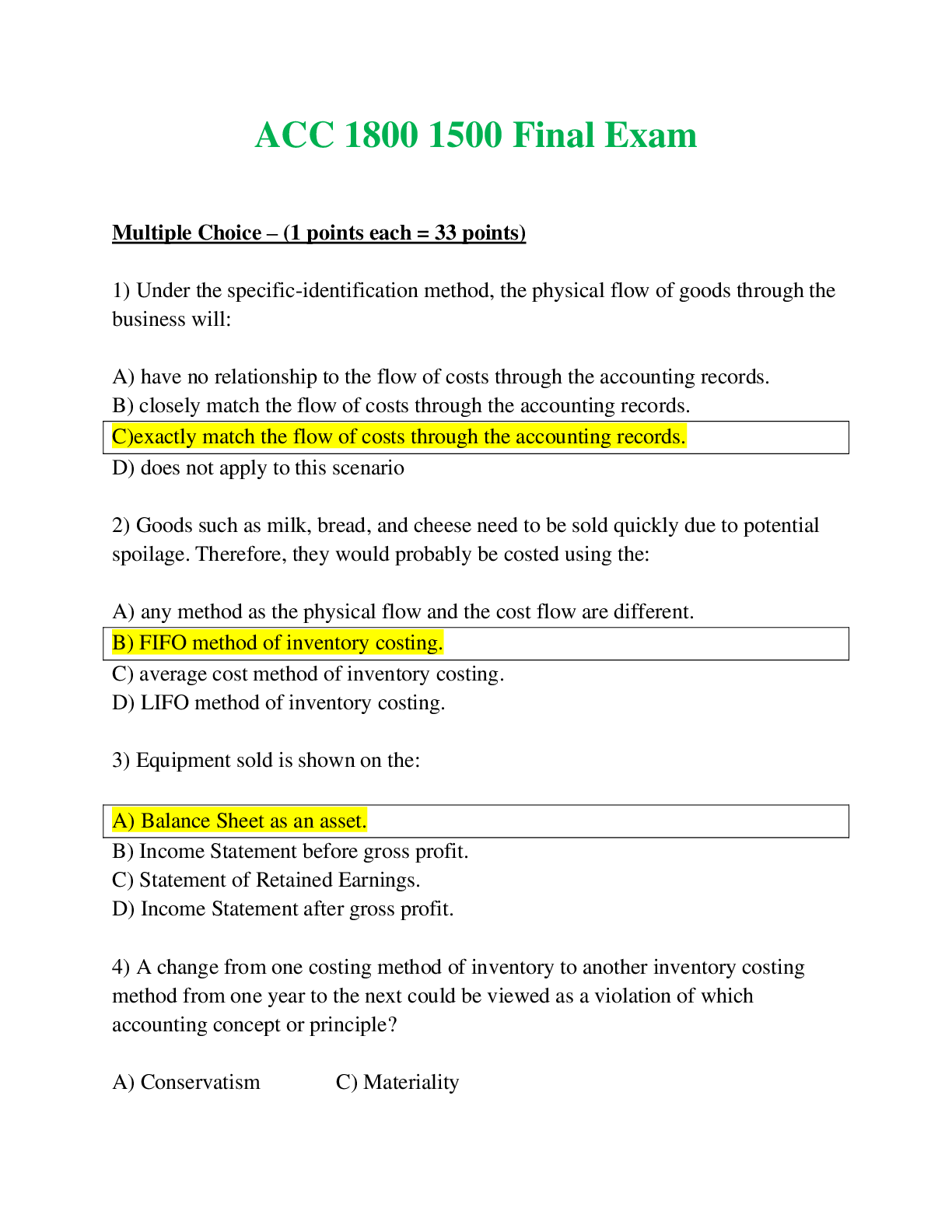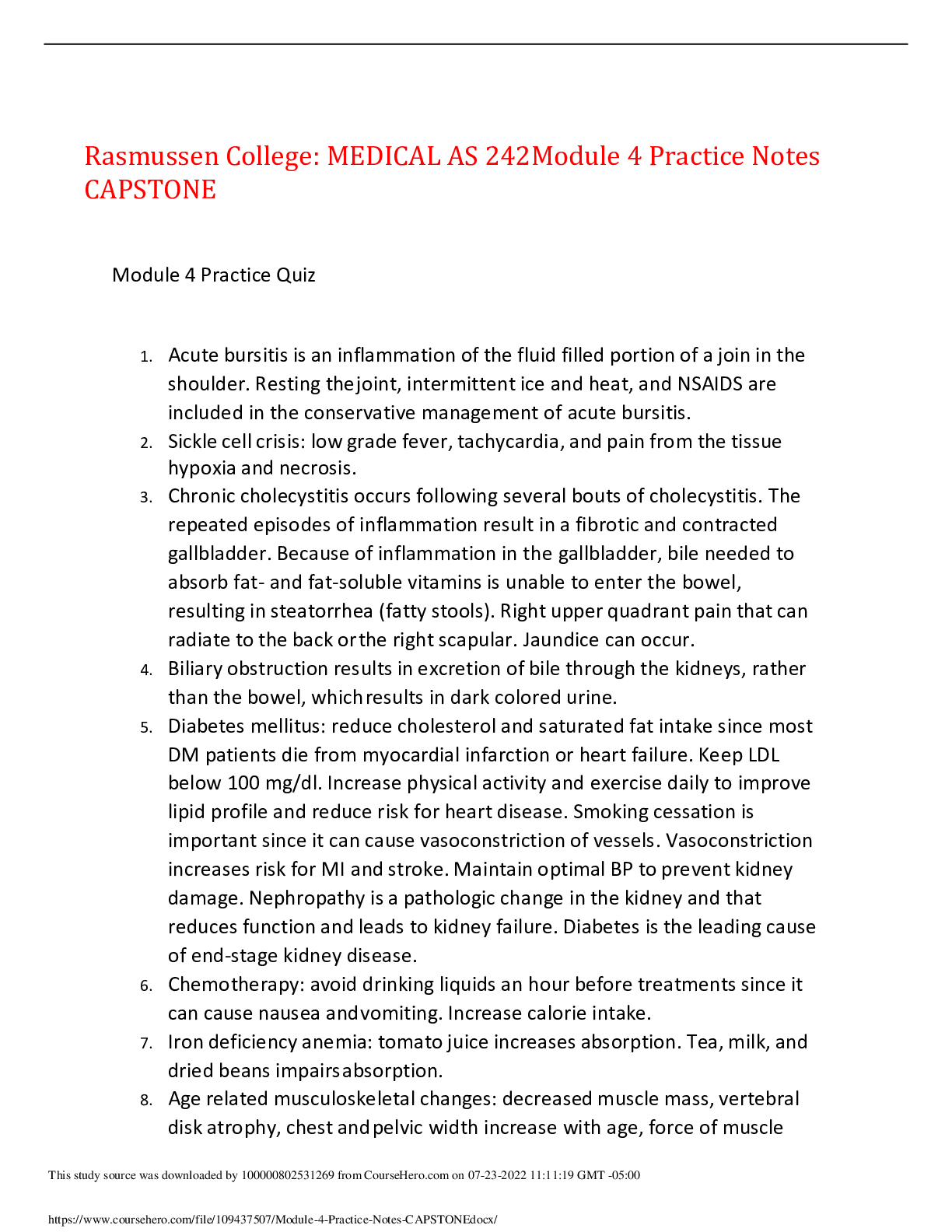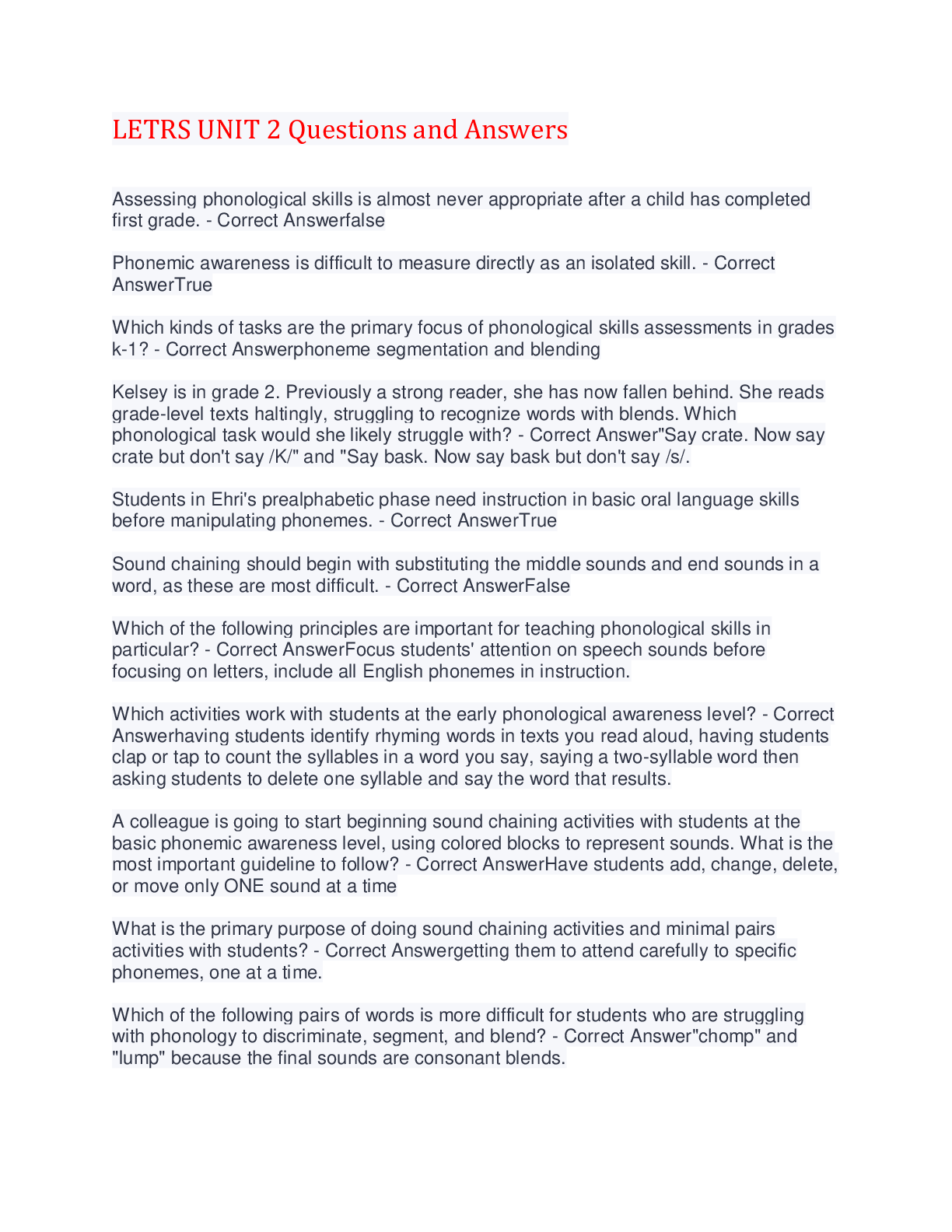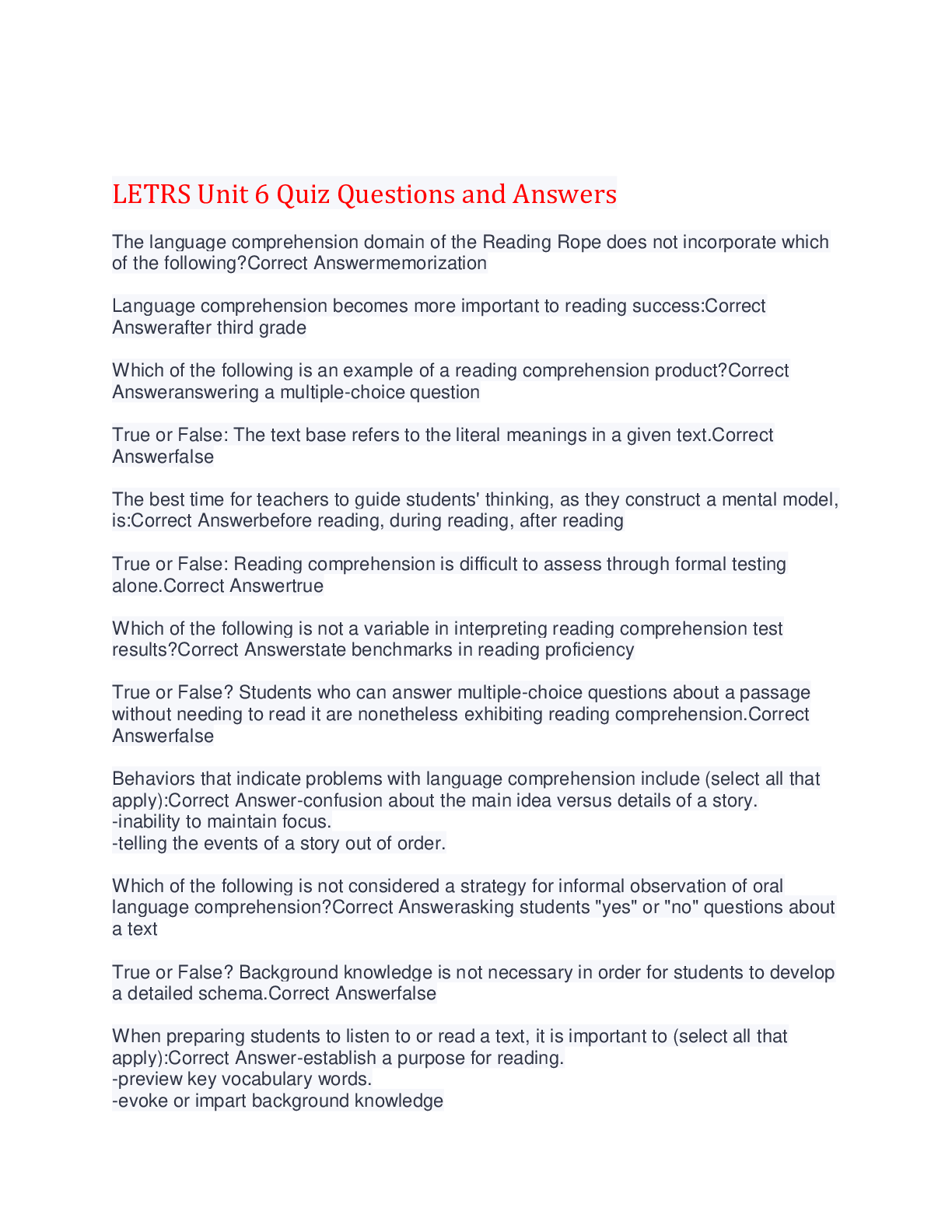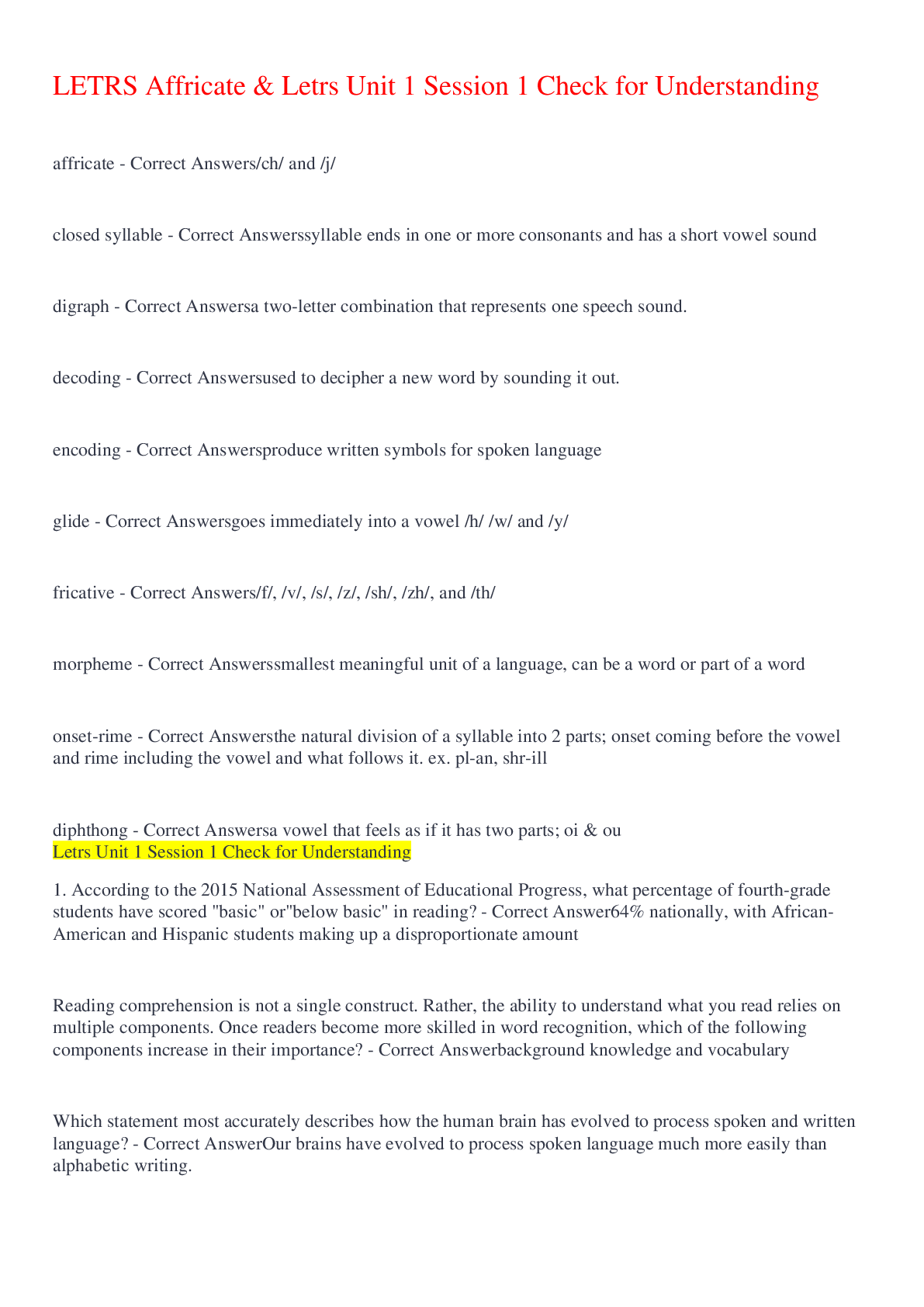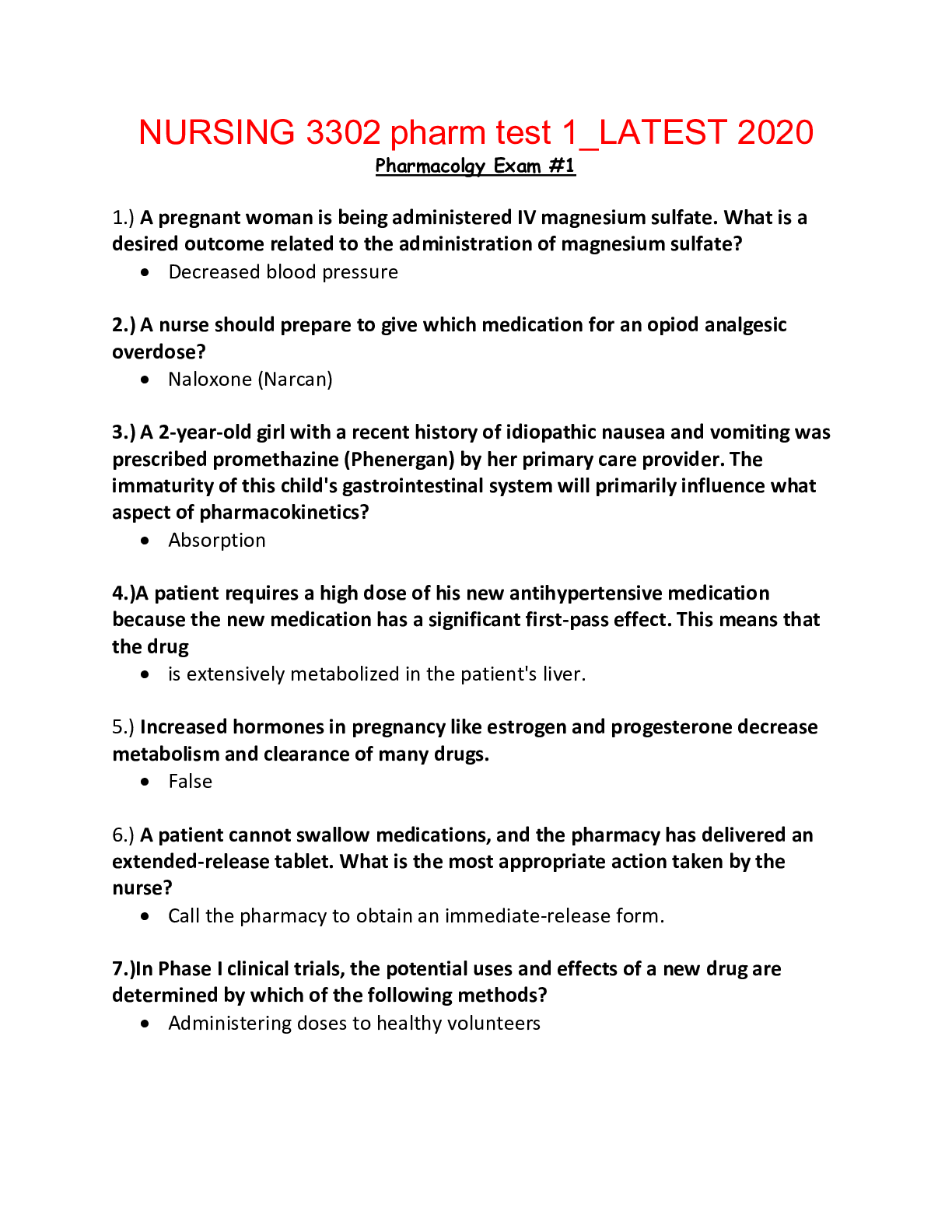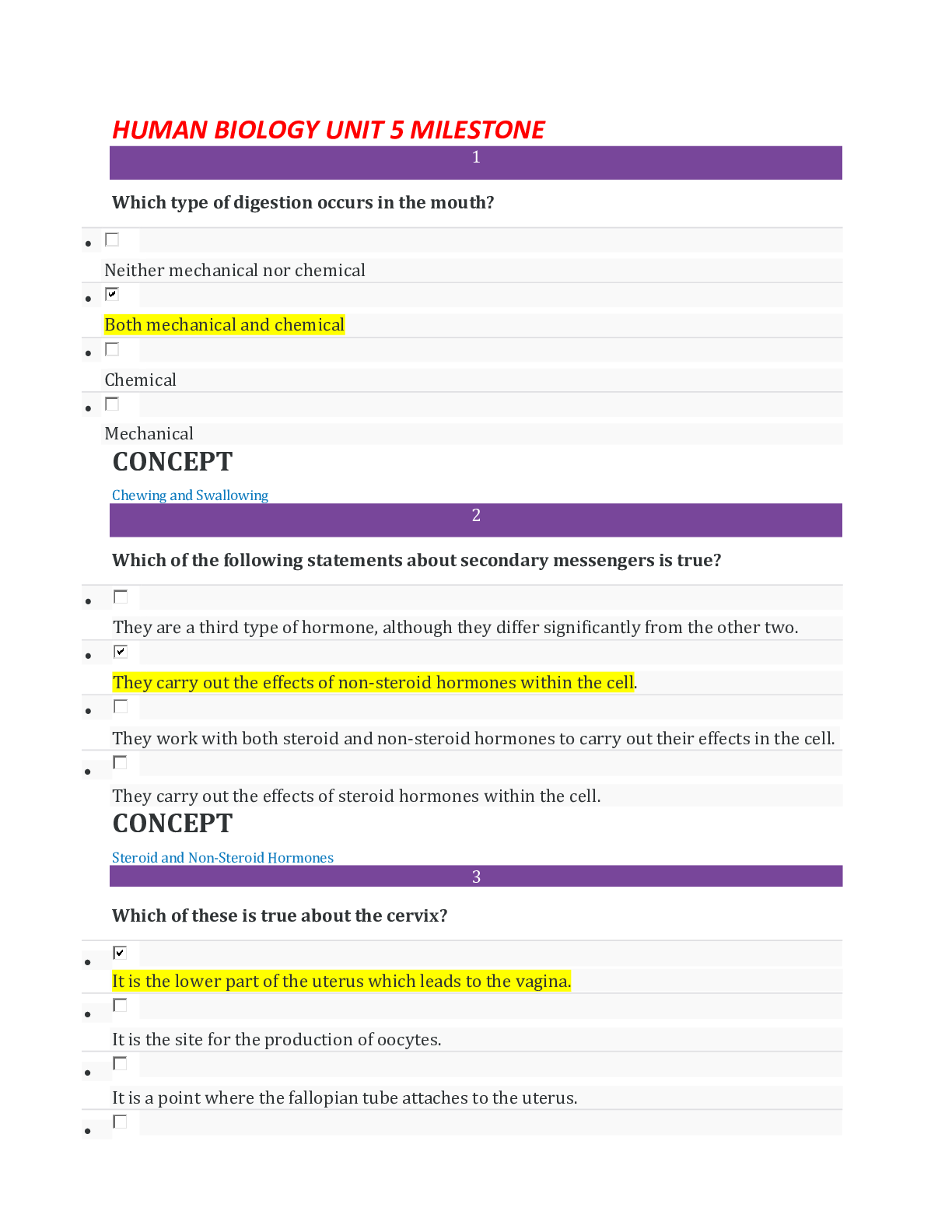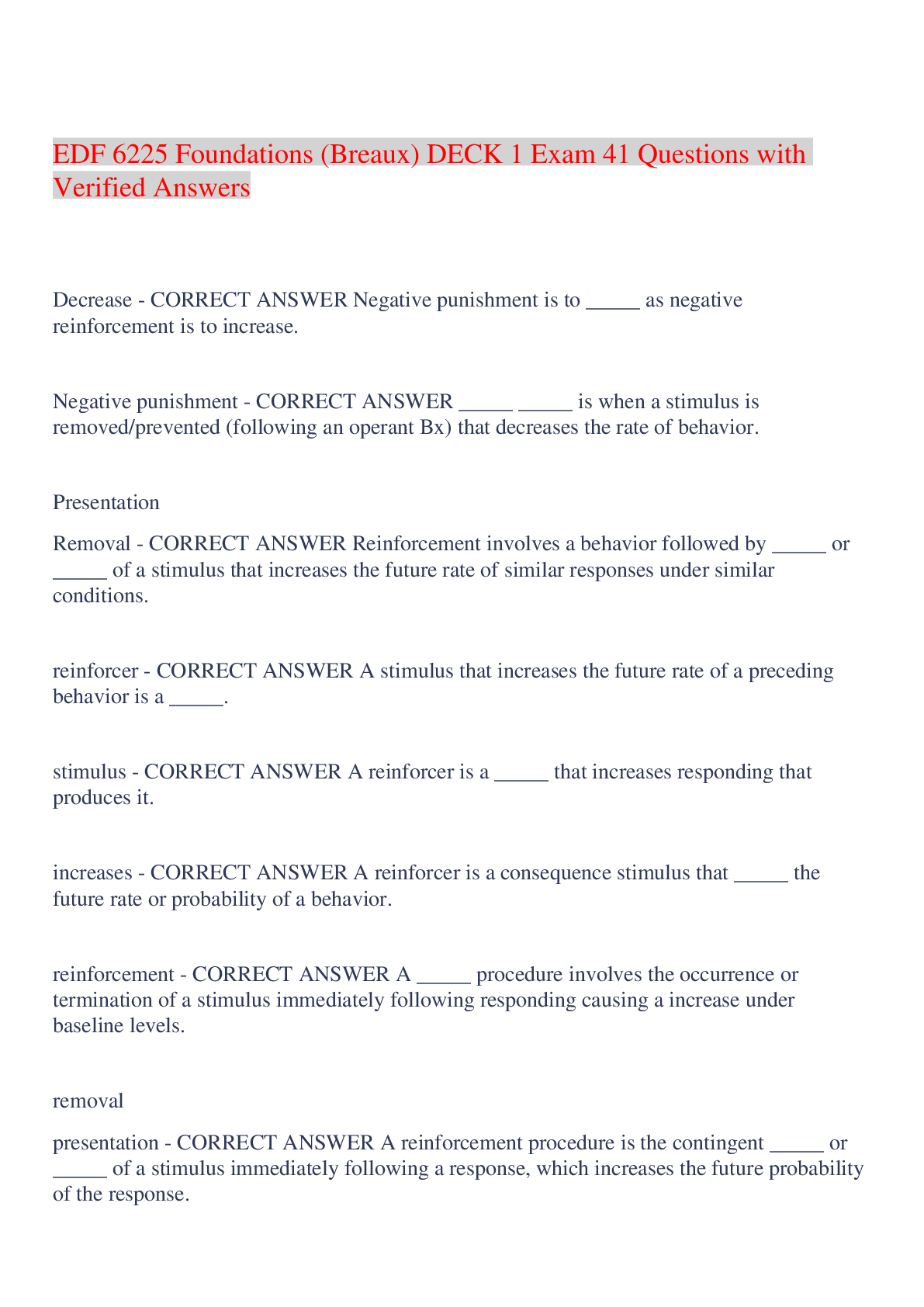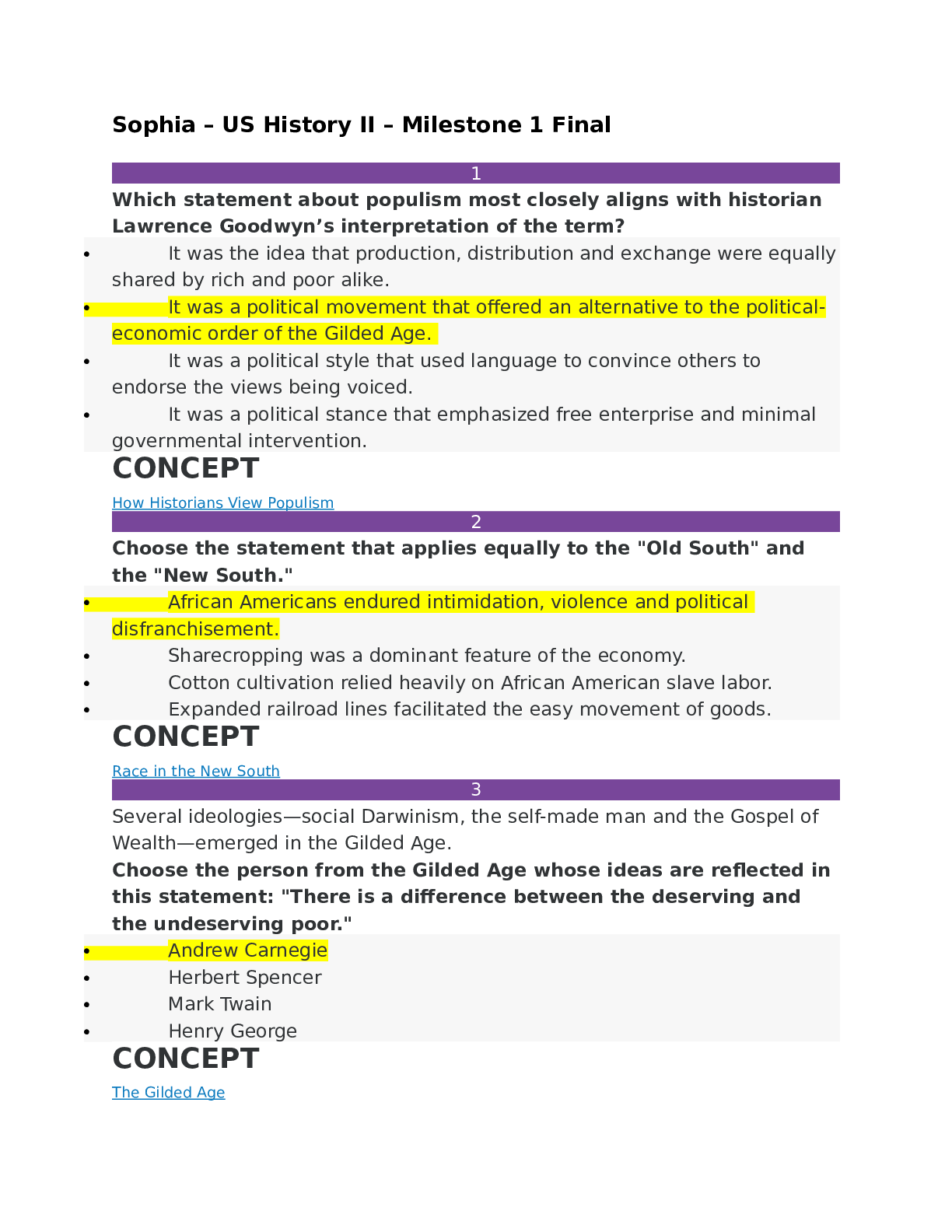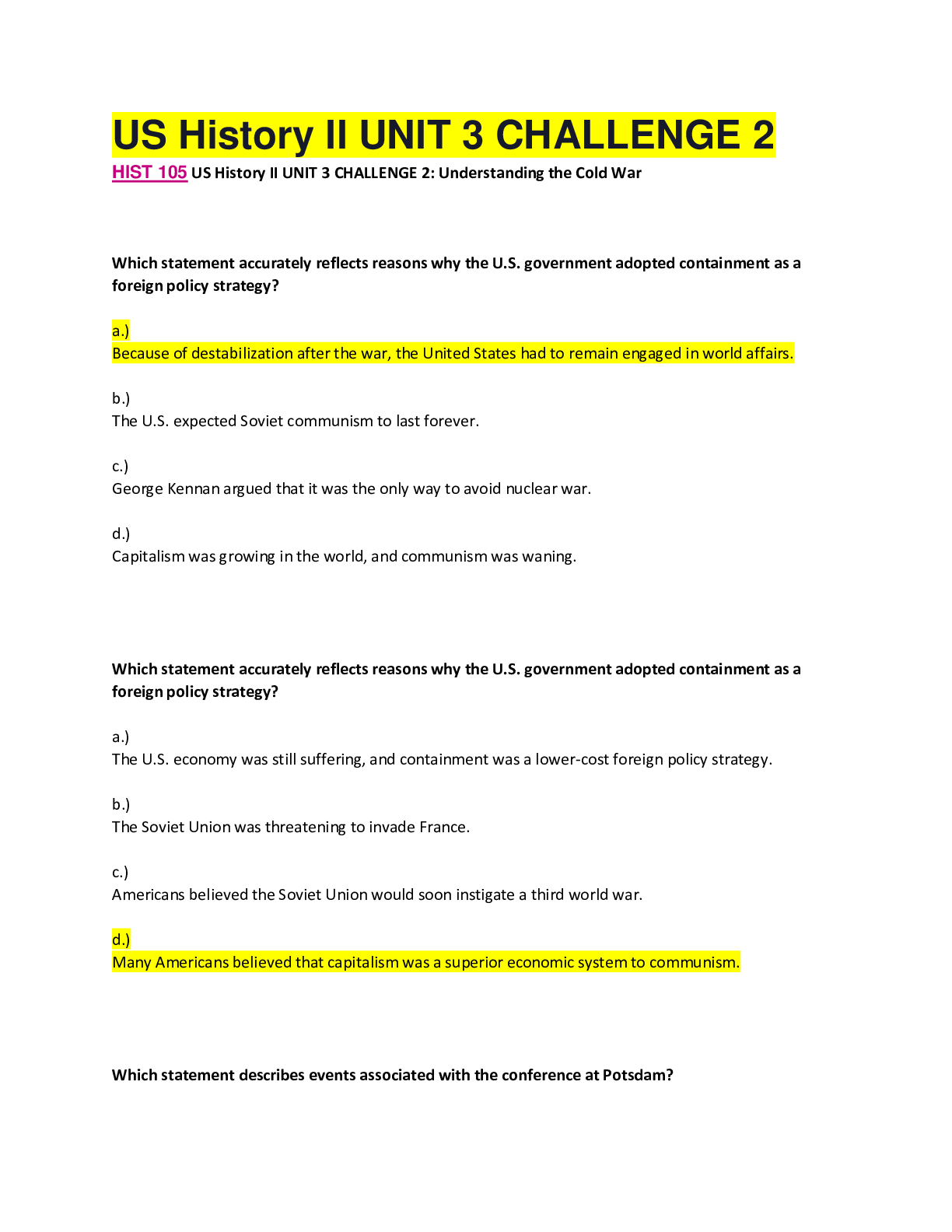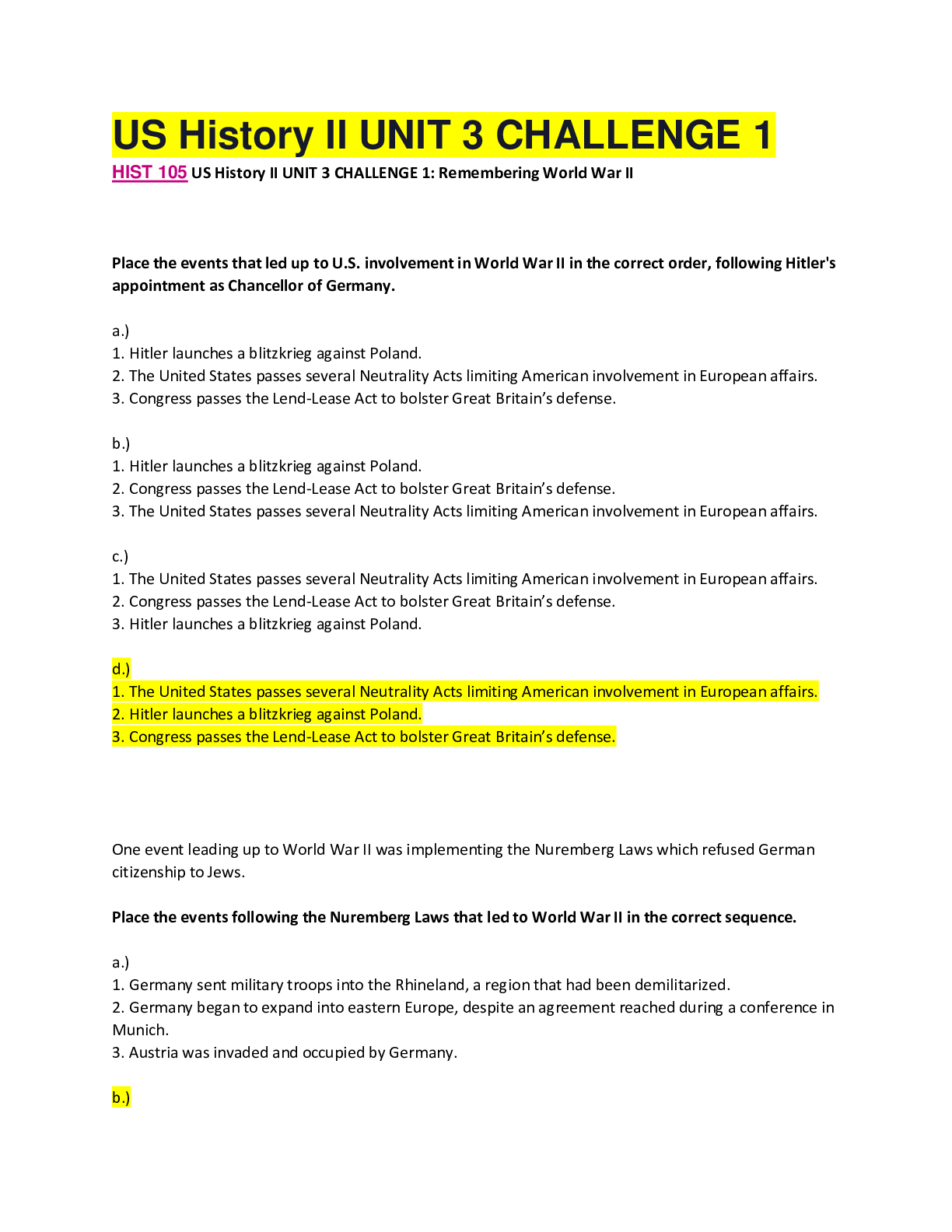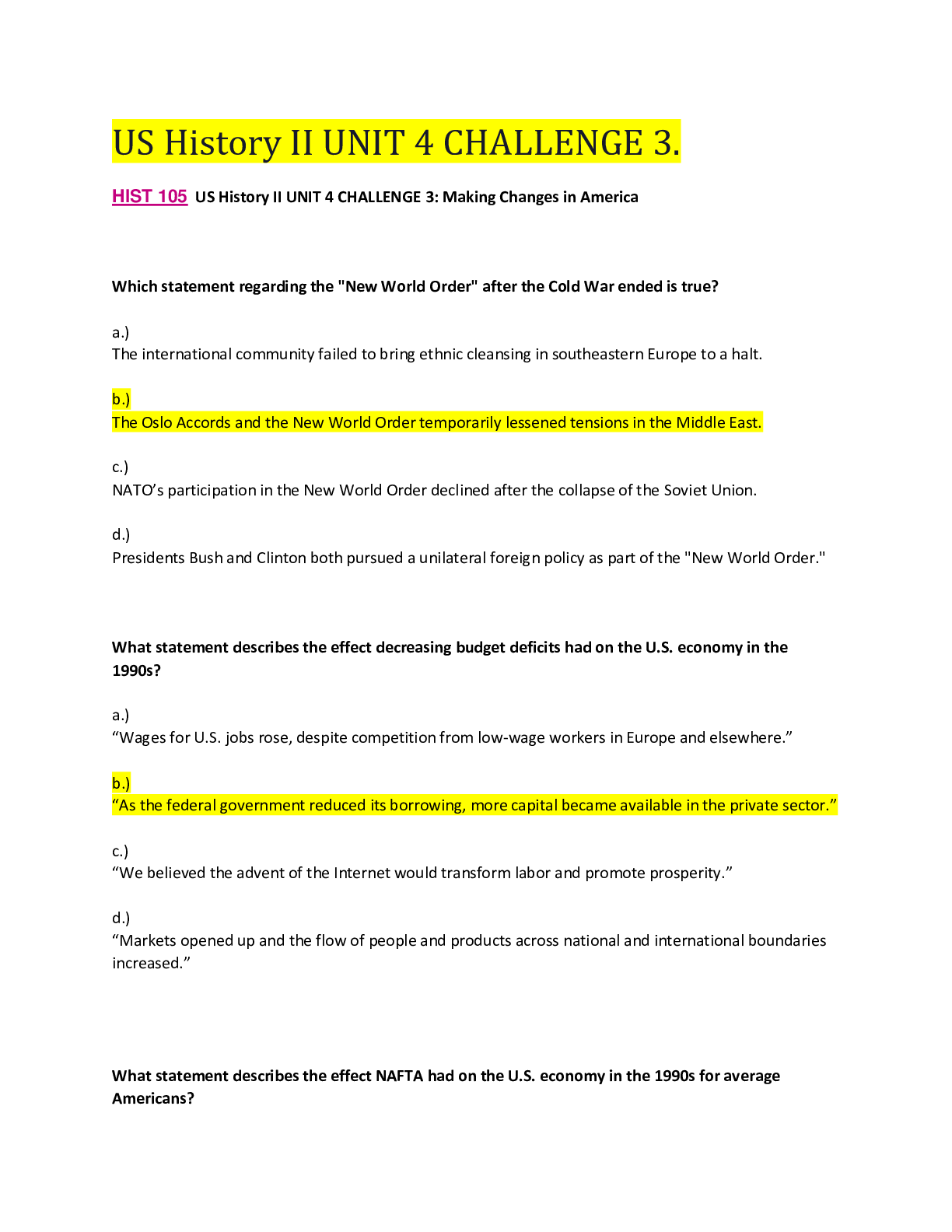Sophia – US History II – Milestone 2 Final,100% CORRECT
Document Content and Description Below
Which of the following was a cause of the Great Depression? • Immigrants had arrived in large numbers during the previous decade and taken many low-paying jobs, leaving many Americans unemployed. ... • Investors and the general public withdrew their money from banks. The more they withdrew, the closer the banks came to collapse. • A rapid rise in population due to a higher birthrate led to a demand for jobs and housing that were just not available. • Consumerism outpaced supply and businesses had insufficient sources for their raw materials, causing prices to skyrocket. 2 President Franklin Roosevelt oversaw both a First New Deal and a Second New Deal to curb the Great Depression. Choose the action that was part of his First New Deal. • The Works Progress Administration provided jobs for more than eight million unemployed workers over an eight-year span. • The Social Security Act established a permanent safety net to help the most vulnerable Americans, including the elderly, the disabled and single parents. • To put Americans back to work quickly, the Public Works Administration contracted with private companies to build highways, bridges and military bases. • The National Labor Relations Act reformed labor relations by protecting American workers’ right to unionize and bargain collectively for wages and benefits. 3 In 1916, pressure from activists and the National Child Labor Committee contributed to legislation that prohibited interstate trade of any goods produced by child labor. What was the name of this legislation? • The Keating-Owen Act • The Redding Trade Compact • The National Consumers League • The U.S. Children’s Bureau 4 Which of the statements reflects President Herbert Hoover’s response to the Great Depression? • “Rather than being paralyzed by fear, we must act now to resolve the banking crisis and other problems associated with the Great Depression.” • "The federal government must step in to provide direct assistance to Americans until this crisis fades." • "The American tradition of rugged individualism can't possibly see the nation and its people through this challenging time." • “I oppose the Federal Emergency Relief Act because it interferes with the balance of power between states and the federal government.” 5 Choose the statement that describes a cause of the War of 1898. • Some Americans saw the Cuban conflict as a dangerous risk for the weak U.S. military. • Yellow journalism inflamed American nationalism with sensational reporting on events in Cuba. • Spain positioned battleships between Cuba and the United States and threatened war. • Uprisings in Cuba over Spanish control were encouraged by businessmen who had investments there. 6 Which statement is most likely to have been spoken by W.E.B. Du Bois, reflecting his approach to black equality in the Progressive Era? • "We must seek to build trust with our white neighbors in the South." • "The best path forward is to provide for our economic welfare by excelling in agriculture, domestic service and other trades." • “I call for immediate and uncompromising activism for African American civil rights in order to achieve social progress.” • “The burden of change is upon us, the African American community; we are responsible for our own success.” 7 Choose the true statement about Progressives or the Progressive Era. • Progressives pushed for the nomination of candidates through a direct vote by party members. • Progressives had lofty goals for political, social and economic reform, but realized little actual policy change. • The Progressive Era represented the apex of racial equality in America. • The Progressive Era marked the emergence of modern conservatism in the country. 8 What was the purpose of Theodore Roosevelt’s “Square Deal?” • Use the government to create a level playing field for all hardworking Americans. • Use the government to establish the United States as a military power on the world stage. • Use the government to address racial violence, inequality and women’s suffrage. • Use the government to ensure big business had the freedom to profit from its efforts. 9 Many historians have argued that the New Deal permanently changed the U.S. Which of the following is a long-term effect of the New Deal identified by historians? • Elderly Americans lost faith in a government that did not consider their needs. • Many more Americans were employed, but wages remained unfairly low. • The government assumed greater responsibility for the security of the people. • The lifting of burdensome regulations made it easier for businesses and corporations to profit. 10 The New Deal transformed the Democratic Party. Choose one example of this transformation. • Party dominance by white Southerners was challenged by new members, including northern liberals and African Americans. • President Franklin Roosevelt formally approached Congress to act on civil rights, including enacting a federal anti-lynching law. • The Democratic Party embraced the ideas of small government, fewer regulations and individual responsibilities. • Democratic leadership in individual states assumed responsibility for their own economic stability and prosperity. 11 Which statement best represents Henry Cabot Lodge's position on American involvement in the proposed League of Nations? • “I urge that sanctions against aggressor nations be included in the League of Nations platform.” • “The U.S. must join the League of Nations, and I will appeal to the American people for public support.” • "I am angry that my colleagues across the aisle aren't open to negotiating." • “I offer 14 reservations I have about the Treaty of Versailles and the League of Nations.” 12 What was one purpose of the Glass-Steagall Act, which was part of Franklin Roosevelt’s First New Deal? • To require federal agencies to assess and evaluate banking practices • To allow banks to form independent financial holding companies • To prohibit commercial banks from engaging in investment banking • To place commercial banks under temporary federal jurisdiction 13 When the United States entered World War I, anti-alcohol groups saw the opportunity to enact a national Prohibition amendment for which of the following reasons? • Public sentiment turned against Wilson, who had long opposed the Prohibition amendment. • Anti-liquor advocates organized hunger strikes outside of the White House. • Military leadership came out in support of the amendment as a critical part of the war effort. • They thought grain should not be used to make beer and liquor when soldiers overseas needed food. 14 Read the sentence from a Chicago newspaper account of a race riot during the Red Summer. Some of the victims were chased, caught and dragged into alleys and lots, where they were left for dead. In all parts of the city, white mobs dragged from surface cars, black passengers wholly ignorant of any trouble, and set upon them. The writer of this account was most likely sympathetic to which group? • Chicago's police • Chicago's working class • Chicago's black population • Chicago's white population 15 After President Woodrow Wilson’s “peace without victory” speech, several events occurred that led to the United States entering World War I. Which of these events most contributed to the United States entering the war? • The Zimmerman Telegram was sent to the German ambassador in Mexico. • Great Britain entered the war following Germany's invasion of Belgium. • Germany developed the U-boat as a weapon of war. • The Mexican Revolution broke out. 16 Although many young Americans in urban areas were associated with the "new generation" during the 1920s, many inhabitants of rural America were part of a "nervous generation." Which of the following describes an aspect of the “nervous generation?” • Fearing change, some were willing to use the power of government to suppress dissent. • Many turned to art produced by expatriates to express their discomfort with modern America. • They looked to science to explain the rapid social changes occurring in America. • Jazz music was central to their political and cultural expression. 17 The Red Scare was a period following World War I in which Americans began to limit radical dissent. Which event is a consequence of the Red Scare? • Americans became concerned about the Russian Revolution. • Radical groups and labor unions raided the offices of federal agents. • Prices for consumer goods doubled within just a few years. • Labor union members of Russian descent were deported to the Soviet Union. 18 The cartoon above was printed in 1907 in the Washington Evening Star. Uncle Sam offers a baseball bat called "National Big Stick" to a player in a Nationals uniform, a reference to President Theodore Roosevelt's big stick diplomacy. Roosevelt had recently offered the Roosevelt Corollary to the Monroe Doctrine, an example of his big stick approach, in 1904. He was also continuing work in the Panama Canal in 1906. Teddy bear, a reference to Roosevelt, assures the player that "it's a victory getter, all right!" How does this cartoon depict the state of American foreign policy in the early 1900s? • The American people were attempting to influence foreign policy through diplomatic channels by promoting sports competitions between nations, referred to as the "National Big Stick." • The American government was tiring of efforts to influence international events and was looking to scale back its military, in a sense retiring its "National Big Stick." • The American government was taking an aggressive foreign policy stance backed by military power, which is represented by the "National Big Stick." • The American people did not care for international affairs and wanted to focus their attention on baseball, the favorite national sport. 19 Study the political cartoon published in Judge in 1905. Which aspect of American foreign policy during the Progressive Era is represented in this image? • European countries were important allies in United States foreign policy. • If other nations failed to submit to the United States, they would be ignored. • United States foreign policy was informed by an emphasis on human rights. • When solving disputes, the United States would act unilaterally. 20 Why did President Theodore Roosevelt use the power of his office to advance Progressive reform? • His prior experiences led him to sympathize with many of the goals of the Progressive movement. • He believed in granting more power to the individual states. • He believed that corporations should be the backbone of the U.S. economy. • The voting public desired a Progressive alternative to the policies of William McKinley. 21 What popular 1920s musical style, which had a quick rhythm and was largely improvised, was associated with the "new generation" of urban young people? • Ragtime • Blues • Jazz • Gospel 22 Consider the case of the Scottsboro Boys, who were arrested in 1931. What does this incident suggest about the state of racial relations during the Great Depression? • Racial bias remained ingrained within society and the justice system. • Blacks were not as adversely affected as whites by the Great Depression. • Racial divides eased somewhat as every citizen was affected by the poor economy. • African Americans were turning to the courts to enforce civil rights. 23 Select a factor that shifted American foreign policy toward imperialism in the 1890s. • Reformers working overseas believed that white Americans had a responsibility to help lesser peoples. • The U.S. government hoped to attract more immigrants to boost the American population. • Josiah Strong wrote a book that explained the strategic benefits of a strong navy. • The U.S. acquired the Virgin Islands and the Dominican Republic to install naval stations. 24 During the 1920s, W. E. B. Du Bois and Marcus Garvey were early proponents of an ideology known as Pan-Africanism. What was a key way in which Garvey's beliefs differed from that of Du Bois? • Garvey believed that black and white Americans were incapable of working together to overcome racism. • Garvey was frustrated over the racism he witnessed and experienced in the United States. • Garvey rejected the notion that African Americans had a distinct racial identity. • Garvey celebrated African American culture and encouraged racial pride. [Show More]
Last updated: 2 years ago
Preview 1 out of 9 pages

Buy this document to get the full access instantly
Instant Download Access after purchase
Buy NowInstant download
We Accept:

Reviews( 0 )
$13.50
Can't find what you want? Try our AI powered Search
Document information
Connected school, study & course
About the document
Uploaded On
Oct 21, 2020
Number of pages
9
Written in
Additional information
This document has been written for:
Uploaded
Oct 21, 2020
Downloads
0
Views
236


